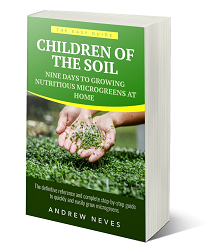Chapter Goal: Introduce you to the four functions of the soil, including the nutrients essential for microgreens, and a few words about hydroponics.
Farming and gardening are not games of chance. If you know the principles, you can use what you learn to change course as conditions change. If your microgreens are not growing well, the problem is in one or more problem areas: light, watering, disease, or soil. In this chapter, we uncover one of the most mysterious ecosystems on the planet, even for experienced gardeners. You probably know that soil has nutrients you can loosen, fertilize, and wet the soil. Before I started growing microgreens, what happened below the soil surface was a mystery to me. You are about to learn what makes microgreens the children of the soil.
| Secret #1: The Seed Bed |
| Storing and conserving soil moisture by carefully preparing and managing the soil is the basis for large and healthy microgreens.
The key to this is the physical condition of the seedbed. It should be fine and firm that it may hold the moisture necessary for vigorous root growth. |
Did you know there are entire textbooks on “soil science?” To grasp the principles of indoor soil gardening, you must first learn something about the structure and habits of microgreens and their relation to the soil. Microgreens, like all plants, require water, food, and air. Unlike animals, they are of the earth. They must manufacture their nutrition from the original elements.
Soil Functions
As a medium for microgreens plant growth, soil performs four functions:
- Anchors roots
- Supplies water
- Provides air
- Furnishes minerals for plant nutrition
Roots
Roots gather food for the microgreens. We find the other elements free in the soil or in various combinations, and it is the business of the roots to go out and gather them in. Root structures are like the structure of branches and leaves. They grow by cell multiplication at the tips. They form a network that pushes its way, searching for air and water that contains nutrients.
| Secret #2: Root Bubbles |
| As the microgreens grow, the body of the roots becomes covered with tiny bubbles of air, preventing the entrance of water.
That is why we water the microgreens from the bottom, not the top. The feeding roots are at the base of the container. Figure 4 Courtesy: Krzysztof Ziarnek, Kenraiz – Cardus utans (seedling) |
Covering the smallest rootlets are millions of microscopic hairs—tiny thread-like filaments called root hairs. These growing rootlets and root hairs absorb water and minerals solution at their tips. Now you know just enough about the functions and habits of the roots to understand how interesting and important they are to growing microgreens. By knowing the root movement, when you water microgreens, you will know where it wants water. However, the roots are not only the food providers of the plant, but they are the water carriers as well. You supply the water, and these workers gather the raw material, build canals, and supply the water for the food factory.

